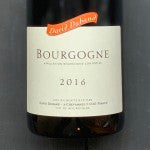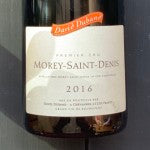Burgundy Quality Levels: A Guided Tasting, at Home
Back in November, as a part of Flatiron Wines’ educational series, I hosted a class entitled ‘Burgundy: On The Level’. In it we discussed the levels of complexity and detail to Burgundy and its Crus.
To help illustrate the how’s and why’s and the lay of the land, we first discussed a brief history of Burgundy’s Côte d’Or (Golden Slope), comprised by Côte de Nuits to the north and Côte de Beaune to the south, along one long hill.
This all boils down to Burgundy and its classifications. This is one of the most important considerations when understanding the region.
Many of the finest vineyards of Burgundy were mapped out hundreds of years ago, by the abbots and monks of the Catholic Church—in Gevrey-Chambertin, there is documentation from as early as 640 C.E. In the ensuing centuries, vineyards were further mapped and tended by the nobility of France, until the Revolution and the influence of Napoleon Bonaparte. Napoleonic inheritance law fractured any prior organization, in effect splitting estates and vineyards into ever-tinier parcels owned by siblings and cousins. Burgundians often joke and disagree when discussing amendments to current classifications. To change a vineyard classification could mean a lifetime (or more) of patience.
With this in mind, we explored these classifications and what to look for on a wine label.
Now, you can taste--and explore--along with us (from the comfort of your couch)!




Are we looking at Bourgogne, a villages, Premier Cru, or Grand Cru? How can we tell a where the wine is from by the label?
- Bourgogne wines are either from designated areas that don't have a village, Premier Cru or Grand Cru classification OR they are declassified grapes from a classified vineyard. Grapes can be from anywhere in Burgundy.
- Village wines are from a designated list of vineyards that are meant to producer higher quality wines than their generic counterparts. The wines do not include the words 1er Cru or Premier Cru. They can occasionally contain the name of a named vineyard. All of the grapes come from that village (or name vineyard).
- Premier Cru wines have the village listed ALONG with the words "Premier Cru" or 1er Cru". The Premier Cru listed is the named vineyard and implies a higher quality wine. All of the grapes must come from the designated vineyard.
- Grand Cru list ONLY the name of the vineyard. This can be confused with the Villages. Luckily the list of Grand Cru's is short (32 vineyards), in short supply and high in price. These are considered the creme de la creme of Burgundy.
Are the wines made the same?
- Winemakers make and age wine according to their own philosophy; There is not a one size fits all answer.
- Bourgogne wines rarely see any aging time in new oak and are often aged for much shorter periods of time than their village-named counterparts.
- Premier and Grand Cru wines often see more time in some new oak barrels, or even all new barrels. They also age for a longer time before being released.
- Often times Grand Cru wines come from vineyards located in the prime sirloin of the slope–the middle–where we tend to find an ideal balance of limestone and clay–thus providing the prime components to provide a wine with structure and succulent fruit. These are usually, but not always, vin de garde, or wine for aging. Of course, this is dependent on the individual producer.
Why is one wine $25.00 and the other $130.00?
- Each designation is a smaller amount of land on which less wine can be produced.
- Centuries ago, the Benedictine monks who mapped out the vineyards designated where the very best wines could be made.
- The production costs at "better" sites is often higher than for those from regional sites. (New oak barrels are EXPENSIVE.)
As we tasted four different wines, of the same vintage, from Côte de Nuits producer, Jerome Chézeaux (Regional, Villages, 1er Cru, Grand Cru) we discussed the differences in each.
- Where in the village is the vineyard located?
- Where on the slope might we find these vines?
- How do the wines differ from each other in character?
- Are we noticing increased length on the palate when we taste Bourgogne Rouge next to Clos Vougeot Grand Cru?
- What was the vinification and élévage (how long a wine is aged and in what sort of vessel, before bottling), and how these choices in the cellar impact the profile of the wine?
One of the main points of discussion and an often asked question:
How will this wine change as it ages?
- A fascinating question, as we often find that in Burgundy the answers to these questions remain fairly uniform. Bourgogne level wines are usually meant to be enjoyed young with plenty of fresh fruit and vibrancy. A perfect addition to a mid-week meal.
- A climb up the classification ladder offers the opportunity for longer aging, greater development and incredible complexity. The wines made from better grapes and are often more concentrated to start. The vibrant fruit starts to age into beautiful mushroom, truffle, spice, tilled earth, smoke, herbal and a slew of other interesting tertiary aromas and flavors. The structure (acid and tannin) is more prevalent in higher quality wines and sometimes even unenjoyable in their youth. As the wines age the structure and flavors integrate while the tannins settle out, leaving a silk or velvet texture.
How do I know when my wine is ready to drink?
- Ask your friendly neighborhood retailer! We can't emphasize this enough! We are a resource at your disposal. Each vineyard, vintage and producer creates a myriad of answers to this question. Everyone enjoys wines at different ages and different styles. The best thing you can do it start drinking and exploring to find out what suits you best. There are plenty of books and online sources with lots of opinions out there. We are happy to help answer any questions you have regarding specific wines! We are happy to help you no matter where you are in your wine journey. Want to know what those 32 Grand Cru sites are? Or, what our favorite wine resource (online or in print) of the moment is? Stop by, and ask away!
Our classroom was full of guests with insightful thoughts and questions. Conversations flowed and many familiar faces returned to the store the very next day to continue the discussion. Our most coveted wines were the Bourgogne and 1er Cru Boudots. For such a young wine (2015), the 1er Cru Boudots was open and fleshy, yet displayed an early glimpse into what one might expect in a gloriously aged Burgundy.
The beauty of the wines of Chézeaux was clearly displayed on this chilly pre-holiday November evening. With a vast and comprehensive selection of Burgundy, we invite you to come into the shop and explore all that this fine region has to offer. Whether a satisfying Bourgogne to pair with your favorite roast chicken recipe or a special bottle of Grand Cru to enjoy alongside truffles – Flatiron has you covered.
If you want to learn more about wine, or about our education series, be sure to sign up for our newsletter and check "Education" as an interest when prompted.


